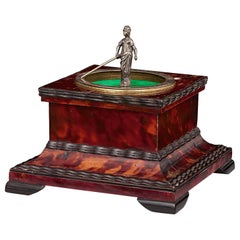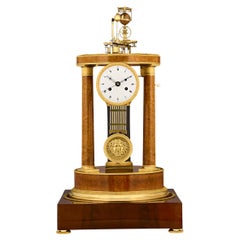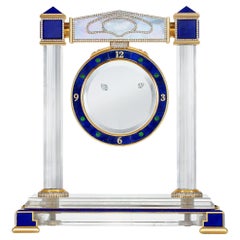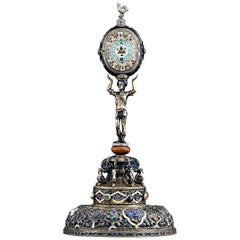Want more images or videos?
Request additional images or videos from the seller
1 of 7
German Renaissance Turret Clock
$68,500List Price
About the Item
- Dimensions:Height: 11.63 in (29.55 cm)Width: 5.38 in (13.67 cm)Depth: 5.38 in (13.67 cm)
- Style:Renaissance (Of the Period)
- Materials and Techniques:
- Place of Origin:
- Period:
- Date of Manufacture:circa 1620
- Condition:Repaired: minor repairs.
- Seller Location:New Orleans, LA
- Reference Number:Seller: 30-16621stDibs: LU891120277702
About the Seller
5.0
Recognized Seller
These prestigious sellers are industry leaders and represent the highest echelon for item quality and design.
Established in 1912
1stDibs seller since 2010
114 sales on 1stDibs
Typical response time: 4 hours
Authenticity Guarantee
In the unlikely event there’s an issue with an item’s authenticity, contact us within 1 year for a full refund. DetailsMoney-Back Guarantee
If your item is not as described, is damaged in transit, or does not arrive, contact us within 7 days for a full refund. Details24-Hour Cancellation
You have a 24-hour grace period in which to reconsider your purchase, with no questions asked.Vetted Professional Sellers
Our world-class sellers must adhere to strict standards for service and quality, maintaining the integrity of our listings.Price-Match Guarantee
If you find that a seller listed the same item for a lower price elsewhere, we’ll match it.Trusted Global Delivery
Our best-in-class carrier network provides specialized shipping options worldwide, including custom delivery.You May Also Like
19th C. Turret Clock Face, French Terra Cotta
Located in Kent, CT
A beautiful 19th Century French Turret Clock labeled "Noit Paris." with a cast iron frame and painted terra cotta face. There are two removable, black-painted clock hands. In good an...
Category
Antique 19th Century French Wall Clocks
Materials
Iron
Huge French Copper Turret Clock Hands for Decorative Use
By Brillie
Located in Nottingham, GB
Reclaimed Copper Clock Hands from a French Turret Clock
A stunning set of clock hands which would of previously grace a French tower clock.
French made dated around 1900
Made enti...
Category
Antique Early 1900s British Industrial Wall Clocks
Materials
Copper
E. F. Caldwell Renaissance Revival Clock
By Edward F. Caldwell & Co.
Located in New York, NY
Gilded and Patinated Bronze Mounted Renaissance Revival Mantel Clock with blue enamel detail
This highly ornamented clock from the renowned E.F. Caldwell company is an incredible ex...
Category
Early 20th Century American Renaissance Revival Mantel Clocks
Materials
Marble, Bronze, Enamel
18th century Swedish turret clock face and movement Rosendal palace
Located in Debenham, Suffolk
Here we offer you the chance to own a unique piece of history circa 1787.
Here is a turret clock face and most of the movement reclaimed from rosendal palace in sweden.
'rosendal p...
Category
Antique Late 18th Century Swedish Baroque Revival Wall Clocks
Materials
Iron, Lead
$7,623 / set
H 46.75 in W 47.5 in D 1 in
German Meissen Porcelain Clock
Located in Queens, NY
German Meissen (19th Century) porcelain group of men and women with floral and bronze branches around mantel clock (not working)
Category
Antique 19th Century German Neoclassical Mantel Clocks
Materials
Bronze
Junghans Germany Wall Clock, 1950
By Max Bill, Junghans Uhren GmbH
Located in Los Angeles, CA
Rare, oval ceramic wall clock, attributed to Max Bill for Junghans Germany, 1950, with a Dual tone ceramic housing, powered by mechanical manual-winding clockwork, in fine working co...
Category
Vintage 1950s German Mid-Century Modern Wall Clocks
Materials
Brass
A Monumental Renaissance Revival Clock Garniture, Attributed to Feuchère
Located in Brighton, West Sussex
A Large and Important Louis Philippe Period Gilt-Bronze Three-Piece Clock Garniture.
Attributed to the Feuchère family. The clock movement by Hémon.
In the Renaissance revival style. Comprising a clock and a pair of nine-light candelabra. The clock case of architectural out-shape with cherubic term figures supporting a rectangular pediment centred by an urn. The sides of the clock tower cast in relief with strapwork and foliage. The dial inset with enamel Roman numeral chapters. The twin-barrel clock movement with tic-tac escapement, silk suspension and countwheel strike to bell. Pendulum and winding key.
The candelabra as twin-handled vases supporting tiered branches with candle nozzles. Modelled en suite with naturalistic scrolls and foliage. Surmounted by finials modelled as an eagle toying with a serpent. The scrolled handles flanked by cherubic figures and serpents. The bodies fronted by bacchic masks and supported on socles bearing angels.
France, Circa 1835.
The clock movement signed ‘HEMON A PARIS’. The clockmaker Claude Hémon was established at rue de St. Martin circa 1810-1820.
Dimensions, the clock:
Height : 106 cm 42 inches
Width : 58 cm 23 inches
Depth : 38 cm 15 inches
Weight : 72 kg
Dimensions, the candelabra:
Height : 104 cm 41 inches
Width : 36 cm 14 inches
Depth : 36 cm 14 inches
Weight : 28 kg (each)
This magnificent clock garniture of palatial size is designed in the Renaissance revival style and dates to the Louis Philippe period. Executed in sculptural gilt-bronze with leaves, scrolls, masks and exotic birds, the naturalistic ornament represents an elaborate system of allegories and mythological iconography which recall the influence of Italian Mannerist art in France.
The distinctive design reflects a new style which replaced the neoclassism of the French Empire period. With the fall of Napoleon Bonaparte, artists and designers sought a new decorative vocabulary with which to aggrandise the Bourbon restoration. With the French revolution and Louis XVI’s execution still within living memory, it seemed too soon for a revival of the style of the Grand Siècle. Instead they looked further back to the time of François I, whose patronage of Italian artists had brought the Renaissance to France. The idea of a renaissance revival appealed to the new Bourbon monarchs and their patronage ignited great creativity in the arts.
The reigns of Louis XVIII and Charles X, who were brothers of the late King, Louis XVI, and later of Louis Philippe I, nicknamed the Citizen King, coincided with the enlightenment and the dawn of the industrial age. Great technical progress was made in metallurgy and casting which raised the art of bronze making to new heights in the hands of great masters such as Pierre-Philippe Thomire (1751-1843) and Pierre- Jean-François Denière (1774-1866).
The renaissance provided a rich and varied source book in architecture, furniture and other decorative arts for designers such as Claude Aimé Chenavard (1798-1838) whose Album de l’ornemaniste (1835) became a reference work. Léon Feuchère (1804-1857) also produced drawings of interiors, silver, bronzes and furniture and was a scion of the prominent family of bronze castors established by his grandfather Pierre-François Feuchère (1737-1823) who had worked as a gilder for the bronze caster Pierre Gouthière before setting up a bronze foundry that would become one of the largest in Paris under the management of his son Lucien-François (d. 1841) and grand-son Armand (1797-1866). A number of drawings by Léon Feuchère have recently been discovered by the Rijksmuseum and probably belonged to the collection of Louis-Philippe-Albert, duc d’Orléans, comte de Paris (1838-1894). Louis-Philippe-Albert was the grandson of the French king, Louis-Philippe I (1773-1850), who granted him the title of comte de Paris, and the son of Ferdinand-Philippe, duc d’Orléans (1810-1842). Ferdinand-Philippe was an important collector and sponsored many young artists to create metalwork objets d’art, notably a celebrated surtout de table made by Claude-Aimé Chenavard and Jean-Jacques Feuchère (1807-1852), a cousin of Armand and Léon. Principally remembered as a sculptor, Jean-Jacques Feuchère trained in the family foundry and designed small objects, cigar boxes...
Category
Antique Early 19th Century French Renaissance Revival Mantel Clocks
Materials
Bronze
$252,067
H 41.74 in W 22.84 in D 14.97 in
Renaissance Style Gilt Bronze and Enamel Mantel Clock
Located in London, GB
Renaissance style gilt bronze and enamel mantel clock
French, late 19th century
Measures: Height 53cm, width 28cm, depth 23cm
This exquisite mantel clock is crafted in the idios...
Category
Antique Late 19th Century French Renaissance Revival Mantel Clocks
Materials
Ormolu, Bronze, Enamel
Renaissance Revival Enamel and Gilt Bronze Mantel Clock
Located in London, GB
Renaissance Revival enamel and gilt bronze mantel clock
French, late 19th century
Size: Height 53cm, width 29cm, depth 22cm
The mantel clock i...
Category
Antique Late 19th Century French Renaissance Revival Mantel Clocks
Materials
Ormolu, Bronze, Enamel
German Ceramic Wall Clock by Garant
Located in Vienna, AT
Ceramic clock with a mechanic movement with floating anchor made my Garant (later Hugo Hättich) in Germany in the early 1950s.
Delivery time about 2-3 weeks.
The movement will be...
Category
Vintage 1950s German Mid-Century Modern Table Clocks and Desk Clocks
Materials
Ceramic, Glass
More From This Seller
View AllBuschman “Minerva” German Horizontal Table Clock
Located in New Orleans, LA
The extraordinary beauty and superior craftsmanship of 17th century German clockmaking is on full display in this exceptionally rare horizontal tabletop timepiece dating to 1650 Augsburg. Created by Johannes Buschman the Younger, the eminent Buschman family of clockmakers are lauded for designing some of the finest timepieces to ever be created in the South German town of Augsburg during the late Renaissance and early Modern periods. A finely moulded ebony and turtleshell casing veneered in a mottled red hue holds the clock’s fusée and chain movement with verge escapement and balance with hogs-bristle regulation. A silver figure of Minerva, Roman goddess of war and wisdom, centers the Roman numeral-engraved chapter ring, indicating the time by pointing to the hour with an authoritative military staff as the sun rotates below her feet to indicate the minute. The incredible design is finished by a gilded backplate intricately pierced and engraved with a floral motif and the signature of Johannes Buschman.
Clocks are one of the greatest and most important inventions of the Renaissance period, improving steadily into the Age of Discovery. Embodying a renewed interest in science, the arts and humanism, the first mechanical timepieces began appearing in the 14th century and were large, weight-driven devices placed in the turrets of public buildings that struck the hour and lacked hands and faces. This clock was created during the first period of household clocks, when spring-driven movements made it possible to create smaller and more complex mechanisms. Such creations, however, were a luxury accessible only to the wealthy upper classes. Affluent patrons placed pressure upon artisans to create more elaborate and ornate clocks...
Category
Antique 17th Century German Renaissance Table Clocks and Desk Clocks
Materials
Silver
Raingo Orrery Clock
Located in New Orleans, LA
Orrery Clock
Zacharie Raingo
Circa 1817
This exceptional orrery clock represents one of the most historically significant and mechanically sophisticated ...
Category
Antique 19th Century French Table Clocks and Desk Clocks
Materials
Bronze, Enamel
$445,000
Floating Diamond Mystery Clock
Located in New Orleans, LA
Floating Diamond Mystery Clock
Movement by Paul Gerber, Case by G. R. Dorschfeldt
Completed in 1994
Movement signed "Paul Gerber"
This floating diamond m...
Category
20th Century Swiss Table Clocks and Desk Clocks
Materials
Lapis Lazuli, Rock Crystal, Gold
$585,000
Viennese Enamel Soldier Clock
By Tobias Katzenberger
Located in New Orleans, LA
A work of exceptional detail, this magnificent Viennese clock takes the art form of enameling to new heights. The elaborately fashioned timepiece rests atop the head of a soldier, who stands on a pedestal populated by sphinxes. Exceptional details encase the entire piece, from the rooster finial to the gem-studded base. A hand-painted portrait of the heroic soldier on the reverse completes this stunning piece.
Particularly popular during the 19th century, Viennese enamels...
Category
Antique Early 19th Century Austrian Other Mantel Clocks
Materials
Multi-gemstone, Enamel
Joe DiMaggio's Presentation Desk Clock
Located in New Orleans, LA
From the personal collection of the legendary Joe DiMaggio, this incredible vintage desk clock was presented to the Yankee Clipper by Harrah's for his par...
Category
20th Century Swiss Other Table Clocks and Desk Clocks
Materials
Brass
French Great Wheel Skeleton Clock
Located in New Orleans, LA
This important glass-fronted French Empire great wheel skeleton clock has the remarkable ability to run with incredible accuracy for more than a week on a single winding. The large central wheel and the rare combination of the pin-wheel escapement and knife-edge suspension allow for a longer, more accurate running time than most clocks of the period. The clock is further distinguished by the inclusion of a concentric calendar dial and Roman numeral chapter ring set amidst a stunning floral halo of gilt bronze fretwork, all mounted on a bronze-wrapped marble base. In such fine, working condition, and with the inclusion of a period glass dome, this clock is exemplary of the finest French skeleton...
Category
Antique 19th Century French Table Clocks and Desk Clocks
Materials
Marble, Bronze
Still Thinking About These?
All Recently ViewedMore Ways To Browse
Antique German Table Clocks
Museum Clock
17th Antique Clock
Turret Clock
Turret Clock Antique Clocks
Antique Brass Table Clock
Crystal Palace Antique
Vintage Alarm Clock
Vintage Enamel Clock
Brass Art Deco Clock
Swiss Antique Clocks Swiss Antique Clocks
Art Deco 1930s Clock
Crystal Clocks
French 1930s Desk
French Louis Xvi Desk White
Lecoultre Clocks
Vintage Lecoultre Clock
Timer Vintage



